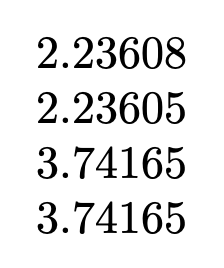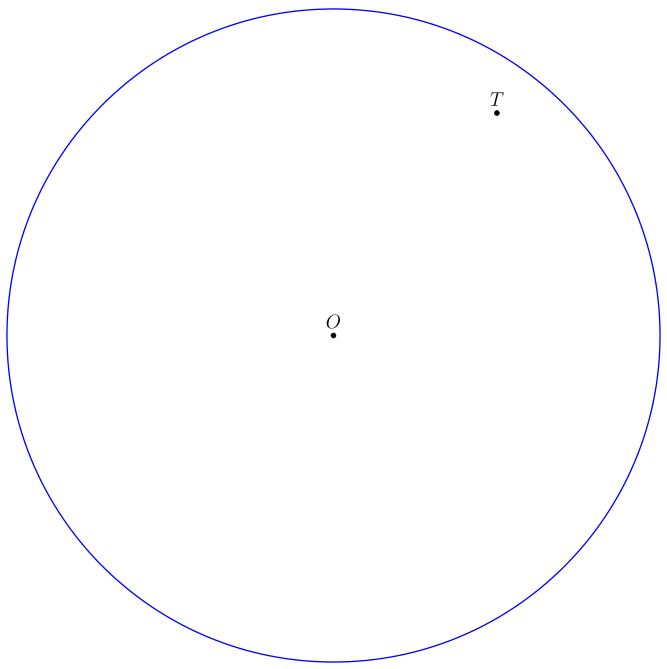Anonymous 1123

I want to draw sphere with centre at O(0,0,0) and passing the point A(2,3,6). I tried
```
\documentclass[border=2mm,12pt,tikz]{standalone}
\usepackage{tikz-3dplot}
\usetikzlibrary{calc}
\begin{document}
\tdplotsetmaincoords{60}{70}
\begin{tikzpicture}[tdplot_main_coords]
\path
(0,0,0) coordinate (O)
(2,3,6) coordinate (T);
\draw[tdplot_screen_coords] (O) let \p1 = ($ (T) - (O) $) in circle ({veclen(\x1,\y1,\z1)});
\end{tikzpicture}
\end{document}
```
I can not get the result. Where is wrong in that code?
Top Answer
user 3.14159

The `veclen` function only takes two arguments. However, it is possible to define pgf functions that take arbitrarily many arguments. Existing examples include the `max` function, which in its original version also was restricted to two arguments. Using the the definition of `max` I define a function `Veclen` which takes arbitrarily many arguments.
```
\documentclass{article}
\usepackage{pgf}
\makeatletter
\pgfmathdeclarefunction{Veclen}{...}{%
\begingroup%
\edef\pgfutil@tempa{0}\relax%
\pgfmathVeclen@@#1{}}
\def\pgfmathVeclen@@#1{%
\def\pgfmath@temp{#1}%
\ifx\pgfmath@temp\pgfmath@empty%
\let\pgfmath@next=\pgfmathVeclen@@@%
\else%
\pgfmathsetmacro\pgfutil@tempa{\pgfutil@tempa+#1*#1}%
\pgfmath@x=\pgfutil@tempa pt\relax%
\let\pgfmath@next=\pgfmathVeclen@@%
\fi%
\pgfmath@next}
\def\pgfmathVeclen@@@{\pgfmathsetmacro\pgfutil@tempa{sqrt(\pgfutil@tempa)}%
\pgfmath@x=\pgfutil@tempa pt\relax%
\pgfmath@returnone\pgfmath@x\endgroup}%
\makeatother
\begin{document}
\noindent\pgfmathparse{veclen(1,2)}\pgfmathresult\par
\noindent\pgfmathparse{Veclen(1,2)}\pgfmathresult\par
\noindent\pgfmathparse{Veclen(1,2,3)}\pgfmathresult\par
\noindent\pgfmathparse{sqrt(14)}\pgfmathresult\par
\end{document}
```

Please note that the currently existing function `veclen` has other deficiencies. It cannot be switched to fpu mode. It may thus be worthwhile to place a feature request to change it to something along the lines outlined above.
Another feature request would be to record the screen depth of each coordinate. Currently, `tikz` has access to the screen coordinates only. It is, in principle, possible to computed and record the screen depth. However, it is very unlikely that such a feature request will be successful.
However, you could use the fact that functions declared with `declare function` can also be arrays. So you can access the components and use them for operations such as the computation of a distance.
```
\documentclass[border=2mm,12pt,tikz]{standalone}
\usepackage{tikz-3dplot}
\makeatletter
\pgfmathdeclarefunction{tddistance}{2}{%
\begingroup%
\pgfmathparse{%
sqrt(({#1}[0]-{#2}[0])*({#1}[0]-{#2}[0])+({#1}[1]-{#2}[1])*({#1}[1]-{#2}[1])+({#1}[2]-{#2}[2])*({#1}[2]-{#2}[2]))}%
\pgfmathsmuggle\pgfmathresult\endgroup%
}%
\makeatother
\tikzset{coorf/.style={insert path={({{#1}[0],{#1}[1],{#1}[2]})}}}
\begin{document}
\tdplotsetmaincoords{60}{70}
\begin{tikzpicture}[tdplot_main_coords,
declare function={O={0,0,0};T={2,3,6};}]
\path
[coorf=O] coordinate (O)
[coorf=T] coordinate (T);
\draw (O) -- (T) node[midway,sloped] {%
\pgfmathparse{tddistance("O","T")}%
\pgfmathprintnumber\pgfmathresult};
\end{tikzpicture}
\end{document}
```

Answer #2
Anonymous 1123

I used `\usetikzlibrary{3dtools}` and tried
```
\documentclass[border=2mm,12pt,tikz]{standalone}
\usepackage{tikz-3dplot}
\usetikzlibrary{calc}
\usetikzlibrary{3dtools}
\begin{document}
\tdplotsetmaincoords{60}{70}
\begin{tikzpicture}[tdplot_main_coords]
\path
(0,0,0) coordinate (O)
(2,3,6) coordinate (T);
\pgfmathsetmacro{\R}{sqrt(TD("(T)-(O)o(T)-(O)")};
\begin{scope}[tdplot_screen_coords]
\draw[blue, thick] (O) circle[radius=\R];
\end{scope}
\foreach \p in {O,T}
{\draw[fill=black] (\p) circle (1.5pt);}
\foreach \p/\g in {O/90,T/90}
{\path (\p)+(\g:3mm) node{$\p$}; }
\end{tikzpicture}
\end{document}
```
